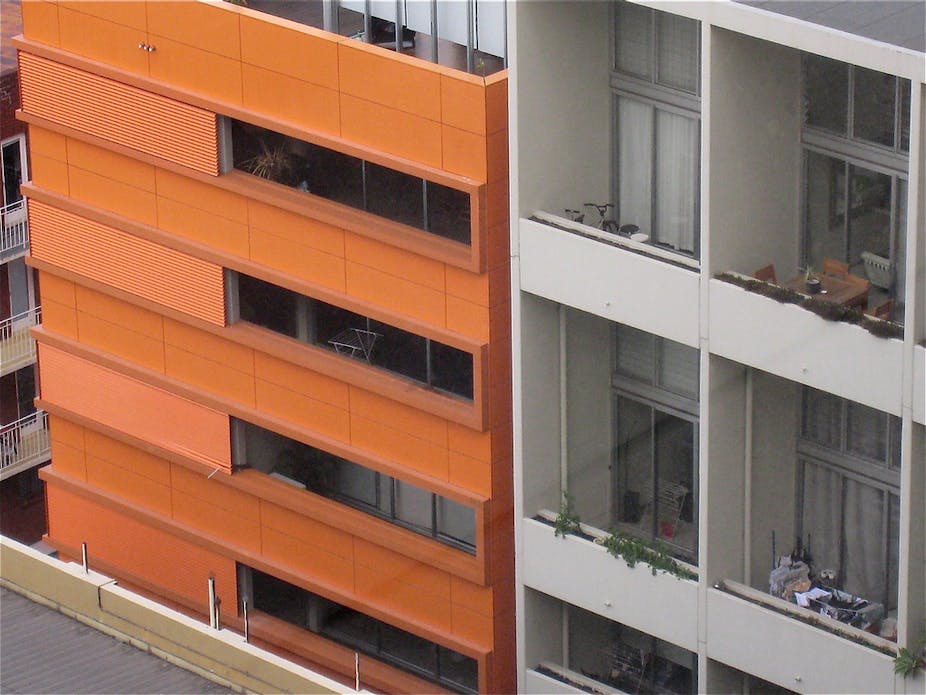AUSTRALIA BY NUMBERS: The Australian Bureau of Statistics has released the first batch of its census data. We’ve asked some of the country’s top demographers and statisticians to crunch the numbers on Australia’s population: how we live, where we work, who our families are and how we spend our time.
Here, ANU’s Liz Allen, Anna Reimondos and Edith Gray look at how we’re living, and the size of Australian homes.
Apartment living may be on the rise, but most Australians are in no hurry to let go of their multi-bedroom houses. Census data released by the Australian Bureau of Statistics last week show that by far the most common dwelling type in 2011 was separate houses (74%). A further 10% of housing was semi-detached (for example, row or terrace houses and townhouses). Flats, units and apartments made up 14% of Australian housing.
In 1991, around 79% were separate houses, 8% were semi-detached, and 11% of dwellings were apartments. In both years, between 1 and 2% of dwellings were described as “other accommodation” - caravans, cabins, improvised homes and flats attached to shops.
Who lives in houses and who lives in apartments?
The type of housing people live in is associated with who lives there. People who live in group households are most likely to live in apartments; around 29% of groups do so. Over a quarter of lone people also live in apartments.
A further 15% of groups and those living alone live in semi-detached housing. Still, both lone-person and group households are more likely to live in a house than an apartment or semi-detached housing, with over 55% of both groups living in freestanding houses.
People who live in family households are most likely to live in houses, and this increases with family size. Over 80% of families with three or more people choose houses.

Are houses getting bigger?
The number of Australians living together has remained almost unchanged: 2.6 people per household in 2011 compared to 2.7 in 1991. The recent stabilisation of household size in the last 20 years comes off the back of a historical decline in the number of people living together.
While average number of people in households has stabilised, the size of Australian homes has undergone a dramatic transformation. The average number of bedrooms has increased slightly from 2.9 to 3.1 over the past 20 years. Although this looks like a small change, there is a noticeable decline in the percentage of homes with few bedrooms, and an increase in housing with four or more bedrooms.
The typical Australian home still has three bedrooms (44%). But this is down from 1991, where around 50% of housing had three bedrooms. The big increase is in four-bedroom homes. In 2011, almost one in three Australian homes has four or more bedrooms, up from around one in five in 1991.
The increase in number of bedrooms is reflected in housing with larger floor plans. Australians are choosing to build houses with greater floor space, making new Australian homes among the biggest worldwide and continuing Australians’ preferences for more spacious homes.
More bedrooms than people to fill them
So what is the relationship between the number of bedrooms in a dwelling and the number of people living there? According to data from the 2011 Census, there are far more bedrooms in Australian homes than there are people.
In 2011 the majority (59%) of three-bedroom homes were occupied by just one or two people. Looking at lone-person households in particular, we can see that only 14% lived in one-bedroom homes, 33% in two-bedroom homes, and 48% in homes with three or more bedrooms.
This apparent mismatch between housing size and the number of occupants is the topic of much debate. It has been argued that houses could be used more efficiently. The term “right-sizing” is used to describe a better match between the number of residents and housing size. This debate calls for a more efficient use of existing housing stock.
But it is a complex issue. There are emotional, practical and financial reasons why people live in houses that may be considered too large for them. For example, emotional ties are one reason that older women may be reluctant to move from their family home.
In practical terms, there are many examples why people may live in houses with extra bedrooms. Divorced parents may have extra rooms for when their children come to stay. Similarly, unoccupied or “extra” bedrooms are often used for recreation and storage spaces.
Other considerations include rooms for planned children, as well as spaces for visitors. Research with older people found that additional bedrooms are being regularly used and that they regard their space as being suitable for their needs.
Finally, there are many financial reasons - in particular taxes and duties - that can be a barrier to moving.
The Australian dream of the three-bedroom detached home is still alive and well. No matter the situation, Australians still seem to prefer living in larger houses.

